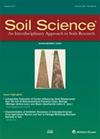What comes after the Sun? On the integration of soil biogeochemical pre-weathering into microplastic experiments
4区 农林科学
Q2 Agricultural and Biological Sciences
引用次数: 4
Abstract
Abstract. Recent studies have been engaged in estimating the adverse effects of microplastic (MP) on soil quality parameters. Mass concentrations of MP, as found in highly contaminated soils, have been shown to weaken the soil structure, and parts of the edaphon are adversely affected mainly by the <100 µm MP size fraction. However, the vast majority of these studies used pristine particles, which have surface characteristics different from those of environmental MP. Exposed to UV radiation, plastic undergoes photochemical weathering with embrittlement and the formation of surface charge, leading to an alteration of physiochemical behavior. When plastic particles then enter the soil environment, further aging factors appear with yet unknown efficacy. This little explored soil biogeochemical phase includes biofilm cover, decay with enzymes (as shown in laboratory experiments with both conventional and biodegradable plastics), contact with biotic and abiotic acids, oxidants, and uptake by the soil fauna that causes physical fragmentation. Such transformation of the surfaces is assumed to affect soil aggregation processes, soil faunal health, and the transport of plastic colloids and adsorbed solubles. This perspective article encourages us to consider the weathering history of MP in soil experiments and highlights the need for reproducing the surface characteristics of soil MP to conduct laboratory experiments with closer-to-nature results.太阳之后是什么?土壤生物地球化学预风化与微塑性试验的整合研究
摘要近年来,人们对微塑料对土壤质量参数的不利影响进行了研究。在高污染土壤中发现的高质量浓度的多聚磷已被证明会削弱土壤结构,部分土壤主要受到<100µm多聚磷粒径分数的不利影响。然而,这些研究绝大多数使用的是原始颗粒,其表面特征与环境MP不同。暴露在紫外线辐射下,塑料经历光化学风化,产生脆化和表面电荷,导致物理化学行为的改变。当塑料颗粒进入土壤环境时,进一步的老化因素出现,其效力尚不得而知。这个很少被探索的土壤生物地球化学阶段包括生物膜覆盖、酶的腐烂(如常规和可生物降解塑料的实验室实验所示)、与生物和非生物酸、氧化剂的接触,以及被土壤动物吸收导致物理破碎。这种表面的转变被认为会影响土壤聚集过程、土壤动物健康以及塑料胶体和吸附的可溶性物质的运输。这篇前瞻性文章鼓励我们在土壤实验中考虑MP的风化历史,并强调需要再现土壤MP的表面特征,以便进行更接近自然结果的实验室实验。
本文章由计算机程序翻译,如有差异,请以英文原文为准。
求助全文
约1分钟内获得全文
求助全文
来源期刊

Soil Science
农林科学-土壤科学
CiteScore
2.70
自引率
0.00%
发文量
0
审稿时长
4.4 months
期刊介绍:
Cessation.Soil Science satisfies the professional needs of all scientists and laboratory personnel involved in soil and plant research by publishing primary research reports and critical reviews of basic and applied soil science, especially as it relates to soil and plant studies and general environmental soil science.
Each month, Soil Science presents authoritative research articles from an impressive array of discipline: soil chemistry and biochemistry, physics, fertility and nutrition, soil genesis and morphology, soil microbiology and mineralogy. Of immediate relevance to soil scientists-both industrial and academic-this unique publication also has long-range value for agronomists and environmental scientists.
 求助内容:
求助内容: 应助结果提醒方式:
应助结果提醒方式:


